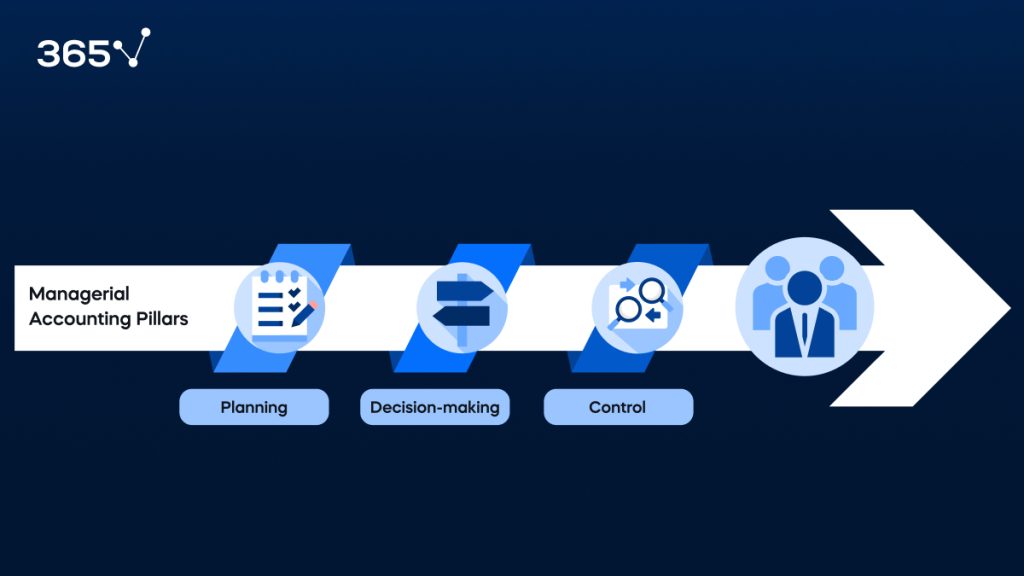What Is Managerial Accounting?
Join over 2 million professionals who advanced their finance careers with 365. Learn from instructors who have worked at Morgan Stanley, HSBC, PwC, and Coca-Cola and master accounting, financial analysis, investment banking, financial modeling, and more.
Start for Free
Managerial accounting is one of the four branches of accounting. It is concerned with a company’s strategic decisions and competitive advantage.
Since it combines analysis with strategic thinking, it is an ideal career path for those with a penchant for turning numbers into insights and an ability to see the bigger picture.
But what do managerial accountants actually do? We start with a definition of managerial accounting, then explain their main functions with an example.
Table of Contents:
- What Is Managerial Accounting?
- Why Is Managerial Accounting Important?
- Managerial Accounting Example
- Next Steps
- FAQs
What Is Managerial Accounting?
Managerial accounting is one of the four fundamental types of accounting. As the name suggests, it deals with the management of business affairs. It is also known as cost accounting because the effective management of a business often comes down to handling its costs.
Managerial accountants are involved in obtaining and processing information on the entirety of the business cycle. These insights allow managers charged with decision-making to respond to pressures and opportunities promptly. Additionally, accountants specializing in the field identify ad hoc accounting information like opportunity costs to make managers aware of potential pitfalls.
The Chartered Institute of Management Accountants (CIMA) is a global body dedicated to managerial accounting. It provides accreditation and sets the standard for best practices in the field.
Why Is Managerial Accounting Important?
Managerial accounting includes the timely identification, measurement, analysis, interpretation, and communication of key financial indicators. This information is usually tailored to the strategic priorities of a specific organization. In other words, the role requires supplying insights into such key business areas as costs, pricing, competition, marginality, budgeting, and a host of others.
Managerial Accounting Example
Managerial accountants employ various tools to empower business managers to make strategic decisions. Let’s look at an example to illustrate some of them.
Drunch is a boutique café located in Mayfair, London. The menu features mostly Mediterranean cuisine and a selection of house-brand chocolates.
The owners—the sisters Paula and Andrea—plan an expansion of their café for next year, which would involve the acquisition of two new outlets in Chelsea and Notting Hill by the end of the current year. They invest heavily in marketing and look into options to update their menu to sustain the expansion. Moreover, they hire a managerial accountant Mark to help them with the planning and execution of their strategy.
What is the managerial accounting role in this case? Mark explains that the pillars of managerial accounting include planning, decision-making, and control. So, his role is to support Paula and Andrea during these stages of the expansion by analyzing data, making predictions and recommendations based on the insights, monitoring the process, and adjusting the strategy accordingly.

Budgeting (Planning)
The first step is to draft a budget. Mark incorporates all expected costs for the upcoming year, such as rent, salaries, and cost of ingredients, and projects expected income from sales (revenue). He then updates the budget monthly by creating rolling forecasts for revenue and expenses. The benefits of budgeting, if done properly, are paramount for every organization, so this is an important managerial accounting task.
Capital Budgeting (Planning)
Expanding the business will include a substantial investment in rental space. While the owners look for suitable locations, Mark’s role is to ensure that they will generate adequate returns on their investment. He can do that by calculating the expected net present value of all related future cash inflows and outflows.
This entails things like determining whether enough customers walk into the café inspired by the location and interior. Is it better to rent corner premises at a higher price or a more isolated one to save on initial capital purchases? Comparing the projected revenue in the two scenarios will reveal which option would render a higher return on investment in the long term.
Absorption Costing (Decision-Making)
Mark’s managerial accounting skills come into use again to help the owners make crucial selling price decisions and determine the costs of items on their menu.
Let’s say the annual fixed overheads for their Mayfair premises is $80,000 and their best-selling dish is the Pink Panther Praline. Mark uses absorption costing to adjust the dish’s price, which allows the cost of fixed overheads to be “absorbed” in the final price of the dish.
He does this by determining an overhead absorption rate (OAR) which utilizes the major activity hours as a base (labor or machine hours). The total annual labor hours needed for the preparation of this bestselling dish are 10,000.
Overhead absorption rate (OAR) = Fixed Overheads / Labor Hours
Hence, OAR = $80,000 / 10,000 hours or $8 per labor hour. Now, each dish uses $10 worth of ingredients and 1 labor hour. So, the final price should be $10 + 1 labor hour ($8 OAR) = $18.
Process Costing and Capacity Management (Decision-Making)
Paula and Andrea need a clear sense of their inventory’s worth. Since they manufacture chocolates in-house, the managerial accounting expert employs process costing to determine the expenses. He factors the value of the work in progress into the final cost of the inventory.
For example:
Opening work in progress= $15,000
Work in progress during the month = $35,000
Closing work in progress = $30,000 So, the value of the work-in-progress units equals opening work in progress + work in progress during the month – closing work in progress. That is, $15,000 + $35,000 – $30,000 = $20,000.
Make-or-Buy Decisions (Decision-Making)
As Mark goes along valuing inventory, he gets an idea. What if it’s more profitable to buy chocolates instead of making them in-house? This is known as a make-or-buy decision, and Mark decides to do the calculation to determine the better choice.
The Cost of Goods Sold (COGS) sustained while making the chocolate is $35,000 per annum, but a local chocolatier is willing to supply the same amount for $32,000 per annum. Based on this, the managerial accounting expert advises the owners to consider purchasing the chocolate instead of making it.
Cost-Volume-Profit Analysis (Decision-Making)
Next, the owners ask Mark to evaluate whether it’s profitable to continue egg royale—a very expensive dish with caviar and salmon.
He conducts cost-volume-profit (CVP) analysis to figure out how many dishes they need to sell to break even. Then, he compares this number with the existing sales of the dish.
CVP (break-even) in units of dishes = fixed costs/contribution per unit, where contribution per unit is selling price per unit – variable cost per unit.
So, let’s say their expected fixed costs for the new location total $50,000 per annum, the selling price per egg royale is $15, and the variable cost per egg royale is $10.
Then, the break-even number of egg royale units will be $50, 000 / ($15 – $10) = $10,000. This means that Drunch needs to sell at least 10,000 egg royale dishes per year to make it a profitable consideration. Otherwise, the managerial accounting advice is to stop making it.
Variance Analysis (Controlling)
When the actual figures for the year are available, Mark compares them with the budgeted ones. This is called variance analysis and is part of the controlling phase.
Suppose that the budgeted marketing expenses were $5,000 for the upcoming year, but the actual expense came up to $6,000. This is known as an adverse variance of $1,000. When this happens, the managerial accounting expert must investigate the cause and come up with a solution to avoid going over budget next time.
This concludes Mark’s work on Drunch’s expansion project. Of course, the example covers just some of the crucial managerial accounting functions. We could add a host of others, such as constraint analysis, cash flow analysis, etc., but the best way to learn core managerial accounting skills is through practice.
Next Steps
Managerial accounting is crucial to business growth as timely identification and rectification of issues allow companies to be at the top of their game. Start gaining the skills to become a successful managerial accountant with our Accounting and Financial Statement Analysis course.
Are you interested in another finance career path?
Our structured Financial Analyst Career Track will open the door to various accounting and financial analysis roles. We also offer expert-led training in investment banking, analysis, and many other sought-after skills in finance. Find the right fit for you and start learning today!
FAQs
Managerial accounting focuses on the internal stakeholders. By analyzing financial and non-financial information, experts derive insights that help managers make informed decisions aligned with the business’s strategy.
The three pillars of managerial accounting are planning, decision-making, and controlling, all of which aim to support the managers’ decision-making. That being said, performance tracking and forecasting are equally important functions.
Financial and managerial accounting are two of the four branches of accounting (the other two being bookkeeping and tax accounting). The difference is that the former assesses financial information to provide analytical insights and long-term projections, while the latter is concerned with the strategic elements of business affairs and short-term insights. In addition, managerial accounting focuses on internal stakeholders, and financial accounting on external stakeholders. Still, there’s some overlap, and finance managers utilize tools from both branches in their daily practice.
